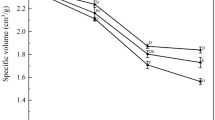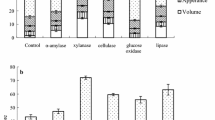Abstract
This study was to evaluate the effect of antifreeze peptides from pigskin collagen hydrolysates (CoAPPs) on the fermentation properties, texture properties, water distribution and water mobility of dough during freezing and freeze–thaw cycles. The fermentation properties of the frozen dough were more stable in the CoAPPs groups than those of control groups. The texture profile analysis showed that the hardness, gumminess and chewiness of the CoAPPs breads were significantly smaller (P < 0.05) than controls. The NMR showed that addition of CoAPPs weakened the influence of the freeze–thaw treatment on water mobility and influenced the water distribution in frozen dough. The results suggest that CoAPPs could potentially serve as a food-origin cryoprotectant in the conventional dough products.







Similar content being viewed by others
Abbreviations
- AFPs:
-
Antifreeze proteins
- THA:
-
Thermal hysteresis ability
- RI:
-
Recrystallization inhibition
- APPs:
-
Antifreeze peptides
- CoAPPs:
-
Antifreeze peptides from pigskin collagen hydrolysates
- TPA:
-
Texture profile analysis
- CPMG:
-
Carr–Purcell–Meiboom–Gill
- MSE:
-
Multiple spin-echo
References
Wu JH, Rong YZ, Wang ZW, Zhou YF, Wang SY, Zhao B (2015) Isolation and characterisation of sericin antifreeze peptides and molecular dynamics modelling of their ice-binding interaction. Food Chem 174:621–629
Damodaran S (2007) Inhibition of ice crystal growth in ice cream mix by gelatin hydrolysate. J Agric Food Chem 55:10918–10923
Wang WL, Chen MS, Wu JH, Wang SY (2015) Hypothermia protection effect of antifreeze peptides from pigskin collagen on freeze-dried Streptococcus thermophiles and its possible action mechanism. LWT Food Sci Technol 63:878–885
Le-Bail A, Zia C, Giannou V (2012) Quality and safety of frozen bakery products. In: Sun DW (ed) Handbook of frozen food processing and packaging, seconded. CRC Press, Boca Raton, pp 501–528
Huen J, Weikusat C, Bayer-Giraldi M, Weikusat I, Ringer L, Lösche K (2014) Confocal raman microscopy of frozen bread dough. J Cereal Sci 60:555–560
Casey GP, Foy JJ (1995) Yeast performance in frozen doughs and strategies for improvement. In: Kulp K, Lorenz K, Brummer J (eds) Frozen and refrigerated doughs and batters. American Association of Cereal Chemists, Minnesota, USA, pp 19–51
Pablo D, Ribotta AE, León-María CA (2003) Effects of yeast freezing in frozen dough. Cereal Chem 80:454–458
Yadav DN, Patki PE, Sharma GK, Bawa AS (2009) Role of ingredients and processing variables on the quality retention in frozen bread doughs: a review. J Food Sci Technol 46:12–20
Loveday SM, Huang VT, Reid DS, Winger RJ (2012) Water dynamics in fresh and frozen yeasted dough. Crit Rev Food Sci Nutr 52:390–409
Li S, Dickinson LC, Chinachoti P (1998) Mobility of “unfreezable” and “freezable” water in waxy corn starch by 2H and 1H NMR. J Agric Food Chem 46:62–71
Zhang C, Zhang H, Wang L, Gao H, Guo XN, Yao HY (2007) Improvement of texture properties and flavor of frozen dough by carrot (Daucuscarota) antifreeze protein supplementation. J Agric Food Chem 55:9620–9626
Ding XL, Zhang H, Wang L, Qian H, Qi XG, Xiao JH (2015) Effect of barley antifreeze protein on thermal properties and water state of dough during freezing and freeze–thaw cycles. Food Hydrocoll 47:32–40
AACC International (2010) Approved method of analysis. 11th edn. AACC International, St. Paul, MN
Ktenioudaki A, Butler F, Gallagher E (2010) Rheological properties and baking quality of wheat varieties from various geographical regions. J Cereal Sci 51:402–408
Anja N, Birch-Frans WJ, Berg BG, Åse H (2013) Expansion profiles of wheat doughs fermented by seven commercial baker’s yeasts. J Cereal Sci 58:318–323
Fiszman SM, Salvador A, Varela P (2005) Methodological developments in bread staling assessment: application to enzyme-supplemented brown pan bread. Eur Food Res Technol 221:616–623
Li J, Hou GG, Chen Z, Chung AL, Gehring K (2014) Studying the effects of whole-wheat flour on the rheological properties and the quality attributes of whole-wheat saltine cracker using SRC, alveograph, rheometer, and NMR technique. LWT Food Sci Technol 55:43–50
Han M, Zhang Y, Fei Y, Xu X, Zhou G (2009) Effect of microbial transglutaminase on NMR relaxometry and microstructure of pork myofibrillar protein gel. Eur Food Res Technol 228(4):665–670
Lu W, Grant L (1999) Effects of prolonged storage at freezing temperatures on starch and baking quality of frozen doughs. Cereal Chem 76:656–662
Jia CL, Huang WN, Wu C, Zhong J, Rayas-Duarte P, Guo CX (2012) Frozen bread dough properties modified by thermostable ice structuring proteins extract from Chinese Privet (Ligustrum vulgare) Leaves. Cereal Chem 89:162–167
Lin LY, Wang H, Lin SD, Liu HM, Mau JL (2013) Changes in buckwheat bread during storage. J Food Process Preserv 37:285–290
Li Z, Deng C, Li H, Liu C, Bian K (2015) Characteristics of remixed fermentation dough and its influence on the quality of steamed bread. Food Chem 179:257–262
Li J, Kang J, Wang L, Li Z, Wang R, Chen ZX, Hou GG (2012) Effect of water migration between arabinoxylans and gluten on baking quality of whole wheat bread detected by magnetic resonance imaging (MRI). J Agric Food Chem 60:6507–6514
Doona CJ, Baik MY (2007) Molecular mobility in model dough systems studied by time-domain nuclear magnetic resonance spectroscopy. J Cereal Sci 45:257–262
Ribotta PD, Leon AE, Anon MC (2001) Effect of freezing and frozen storage of doughs on bread quality. J Agric Food Chem 49:913–918
Vyavahare O, Ng D, Hsu SL (2014) Analysis of structural rearrangements of poly(lactic acid) in the presence of water. J Phys Chem B 118:4185–4193
Phimolsiripol Y, Siripatrawan U, Tulyathan V, Cleland D (2008) Effects of freezing and temperature fluctuations during frozen storage on frozen dough and bread quality. J Food Eng 84:48–56
Giannou V, Kessoglou V, Tzia C (2003) Quality and safety characteristics of bread made from frozen dough. Trends Food Sci Technol 14:99–108
Acknowledgements
This work was supported by Natural Science Foundation of China (No. 31571779, 31471623), the Special National Key Research and Development Plan (No. 2016YFD0400200) China.
Author information
Authors and Affiliations
Corresponding author
Ethics declarations
Conflict of interest
None.
Compliance with ethics requirements
This article does not contain any studies with human or animal subjects.
Additional information
Xu Chen and Jin-hong Wu have contributed equally to this work.
Rights and permissions
About this article
Cite this article
Chen, X., Wu, Jh., Li, L. et al. The cryoprotective effects of antifreeze peptides from pigskin collagen on texture properties and water mobility of frozen dough subjected to freeze–thaw cycles. Eur Food Res Technol 243, 1149–1156 (2017). https://doi.org/10.1007/s00217-016-2830-x
Received:
Revised:
Accepted:
Published:
Issue Date:
DOI: https://doi.org/10.1007/s00217-016-2830-x




